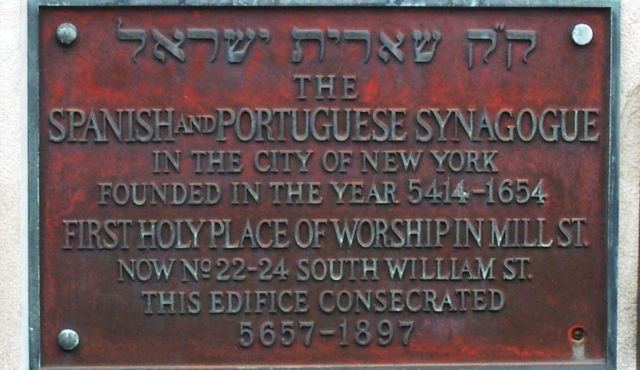Shearith Israel was founded in lower Manhattan more than a century before American independence, and it still exists today.

The first Jews in North America are believed to be 23 refugees from Recife, Brazil, who fled the formerly Dutch outpost when it was reconquered by the Portuguese in 1654, and ended up in New Amsterdam. Although they were not permitted to pray in public, they established a formal community, and in 1656, set up a cemetery. The location of that burial ground is unknown, but the graveyard that followed it, at St. James Place, still stands, the only remaining 17th-century structure in the city.Until 1818, Shearith Israel was the city’s only synagogue, with a membership that was both Sephardi and Ashkenazi in origin. (That remains the case with the synagogue today, although its prayer services follow the Sephardi rite.) In its early decades Shearith Israel rented space for its sanctuary: A map dated 1695 indicates a home on Beaver Street. From 1700, a rented space on Mill Street served the function.
It was only in 1728 that the congregation bought a parcel of land, also on Mill Street, for the construction of its own building. As historian Jonathan Sarna has pointed out, the design of the Mill Street synagogue reflected some of the lessons learned by the Jews regarding their presentation to others over centuries of Diaspora life: “to practice great discretion on the outside, not drawing excessive attention to themselves, while glorying in their faith on the inside, where tradition reigned supreme.”
Women were separated from men, as in all Orthodox synagogues, and seated in a cramped upstairs gallery behind a screen. But whereas in Sephardi congregations in Amsterdam, London or Recife, unmarried women generally did not attend, in New York it was customary for all women, including those were single, to attend Sabbath and holiday services, much as their female Protestant neighbors were expected to attend church. This made for crowding, and especially, to a tendency among single women (or sometimes their fathers, on their behalf) to push for a seat in the first row of the gallery, so as to be seen. A 1744 visitor to the synagogue noted, for example that Shearith Israel’s women, “of whom some were very pritty [sic], stood up in the gallery like a hen coop.”
Finally, in 1792, the congregation passed a resolution that barred any “unmarried lady except Rachel Pinto [who was 70 years old and rich]” from taking a seat in the front gallery.
In 1818, having outgrown its home, the congregation erected a new building on the same site, a brick and stone edifice with 167 seats for men and 133 for women. The women’s section was upstairs, but it was open. It moved again in 1834, in response to a push northward by congregants, to Crosby Street, in what is today SoHo. Since 1897, Shearith Israel – also known as the Spanish-Portuguese Synagogue – has been in its current structure, at 70th Street and Central Park West.
By David B. Green
Published 06:00 08.04.14
Source: Haaretz
 eSefarad Noticias del Mundo Sefaradi
eSefarad Noticias del Mundo Sefaradi

